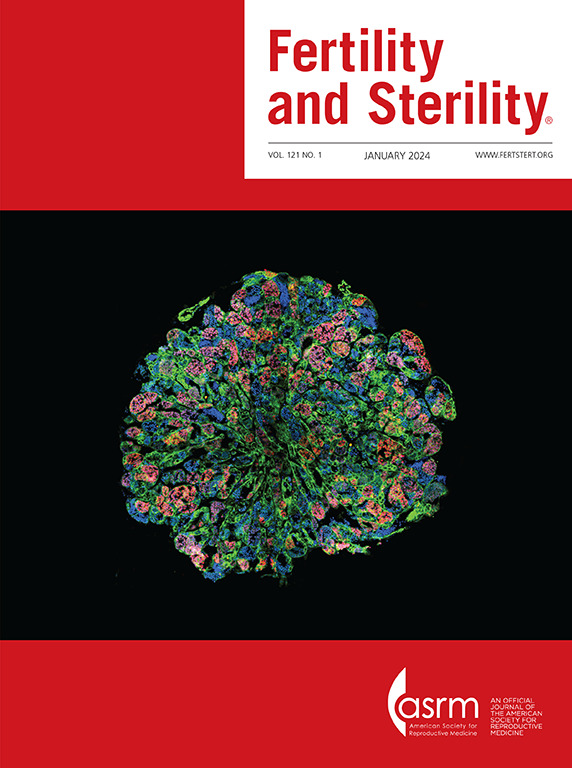血清总睾酮和睾丸组织学有助于预测接受睾丸精子提取的非马赛克Klinefelter患者的阳性精子提取:来自大型多中心队列的真实数据。
IF 7
1区 医学
Q1 OBSTETRICS & GYNECOLOGY
引用次数: 0
摘要
目的探讨非花叶性Klinefelter综合征(KS)男性因主要男性因素夫妇不育求医的实际取精率及预测因素。设计:多中心、回顾性、队列研究。研究对象:数据分析来自意大利12个三级转诊中心2008年至2024年间383名非芬兰人、白种欧洲人、非马赛克KS非阻塞性无精子症(NOA)患者接受TESE的数据。所有患者都接受了全面的诊断检查,包括激素/基因测试和睾丸超声检查。精液分析符合2021年世界卫生组织的标准。记录睾丸组织学。根据外科医生的喜好,采用常规睾丸精子提取(cTESE)或显微外科睾丸精子提取(mTESE)。描述性统计和逻辑回归评估阳性SR (+SR)的预测因子。主要结局:接受cTESE或mTESE治疗NOA的非嵌合KS男性的阳性精子恢复率(+SRR),以及与+SR相关的临床和组织学预测因素的确定。结果中位(IQR)年龄为31岁(25-36岁),睾丸体积为3.8 ml (3-5) ml,基线促卵泡激素和总睾酮(tT)水平分别为31.2 mUI/ ml(21.5-41.8)和3.6 ng/ ml(2.7-5.1)。在383例患者中,50例(13.1%)患者在手术前持续接受睾酮治疗(TTh),该治疗在c/mTESE前至少6个月中断。其中,246名(64.2%)男性接受了cTESE, 345名(90.1%)男性接受了双侧c/mTESE手术。组织学报告显示,仅支持细胞综合征(SCOS)、成熟阻滞(MA)和低精子发生(HS)患者分别为350例(91.4%)、20例(5.2%)和13例(3.4%)。总体而言,114名(29.8%)男性发现+SR。+SR患者tT值高于-SR患者(3.8 vs. 3.6 ng/ml, p=0.03)。与MA和HS相比,SCOS组织学更常与-SR相关(p<0.001)。多变量logistic回归分析证实,较高的基线tT值(OR 1.1, 95% CI 1.02-3.45, p=0.03)和HS组织学(8.8,95% CI 2.96-15.76, p<0.001)与+SR独立相关。结论三分之一的非镶嵌性KS男性在c/mTESE时为+SR。较高的术前tT和睾丸组织学与SR结果独立相关。这些发现可以在临床上为患有NOA的非马赛克KS男性进行c/mTESE前提供量身定制的咨询。本文章由计算机程序翻译,如有差异,请以英文原文为准。
Serum total testosterone and testicular histology help predicting positive sperm retrieval in non-mosaic Klinefelter patients undergoing testicular sperm extraction: real-life data from a large multicenter cohort.
OBJECTIVE
To study real-life rates and predictors of sperm retrieval (SR) in men with non-mosaic Klinefelter syndrome (KS) seeking medical help for primary male factor couple's infertility.
DESIGN
Multicenter, retrospective, cohort study.
SUBJECTS
Data analysis from 383 non-Finnish, white-European, non-mosaic KS men with non-obstructive azoospermia (NOA) undergoing TESE between 2008 and 2024 at 12 tertiary referral centers in Italy.
EXPOSURE
All patients received a comprehensive diagnostic work-up, including hormonal/genetic tests and testicular ultrasound. Semen analysis followed 2021 World Health Organization criteria. Testicular histology was recorded. Either conventional testicular sperm extraction (cTESE) or microsurgical TESE (mTESE) was used, depending on surgeon preference. Descriptive statistics and logistic regression assessed predictors of positive SR (+SR).
MAIN OUTCOME MEASURES
Positive sperm retrieval rate (+SRR) in non-mosaic KS men undergoing cTESE or mTESE for NOA, and the identification of clinical and histological predictors associated with +SR.
RESULTS
Median (IQR) age was 31 years (25-36) and testicular volume was 3.8 ml (3-5) ml. Baseline follicle-stimulating hormone and total testosterone (tT) levels were 31.2 mUI/mL (21.5-41.8) and 3.6 ng/mL (2.7-5.1), respectively. Of 383, 50 (13.1%) patients have been on continuous testosterone therapy (TTh) prior to surgery, which has been interrupted at least 6 months before c/mTESE. Of all, 246 (64.2%) men underwent cTESE and a bilateral c/mTESE procedure was carried out in 345 (90.1%) men. Histologic reports showed Sertoli cell-only syndrome (SCOS), maturation arrest (MA) and hypospermatogenesis (HS) in 350 (91.4%), 20 (5.2%) and 13 (3.4%) patients, respectively. Overall, +SR was found in 114 (29.8%) men. Patients with +SR had higher tT values (3.8 vs. 3.6 ng/ml, p=0.03) than those with -SR. SCOS histology was more frequently associated with -SR compared to both MA and HS (p<0.001). Multivariable logistic regression analysis confirmed that higher baseline tT values (OR 1.1, 95% CI 1.02-3.45, p=0.03) and HS histology (8.8, 95% CI 2.96-15.76, p<0.001) were independently associated with +SR.
CONCLUSIONS
One third of non-mosaic KS men had +SR at c/mTESE. Higher preoperative tT and testicular histology emerged to be independently associated with SR outcomes. These findings can be clinically useful for a tailored counselling before c/mTESE in non-mosaic KS men with NOA.
求助全文
通过发布文献求助,成功后即可免费获取论文全文。
去求助
来源期刊

Fertility and sterility
医学-妇产科学
CiteScore
11.30
自引率
6.00%
发文量
1446
审稿时长
31 days
期刊介绍:
Fertility and Sterility® is an international journal for obstetricians, gynecologists, reproductive endocrinologists, urologists, basic scientists and others who treat and investigate problems of infertility and human reproductive disorders. The journal publishes juried original scientific articles in clinical and laboratory research relevant to reproductive endocrinology, urology, andrology, physiology, immunology, genetics, contraception, and menopause. Fertility and Sterility® encourages and supports meaningful basic and clinical research, and facilitates and promotes excellence in professional education, in the field of reproductive medicine.
 求助内容:
求助内容: 应助结果提醒方式:
应助结果提醒方式:


